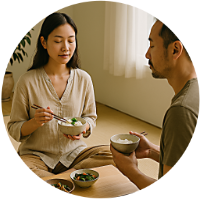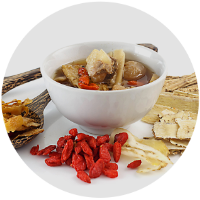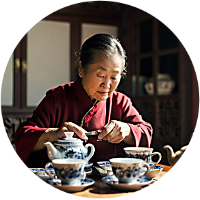The Spirit of the Leaf:
A Journey Through China’s Tea Tradition
Scientific Insights into the
Health Benefits of Tea
Modern research increasingly supports the traditional view that tea promotes health and longevity. Studies have identified a variety of bioactive compounds in tea—most notably polyphenols such as catechins, theaflavins, and flavonoids—that contribute to its therapeutic potential.
Cardiovascular Health: A 2020 study published in the European Journal of Preventive Cardiology followed over 100,000 Chinese adults and found that habitual tea drinkers had a 20% lower risk of developing heart disease and stroke, as well as a 22% reduced risk of fatal cardiovascular events. The protective effect was strongest in those who drank green tea regularly (Liu et al., 2020).
Weight and Metabolism: Green tea catechins, particularly epigallocatechin gallate (EGCG), have been shown to increase fat oxidation and improve metabolic rate. A meta-analysis in Obesity Reviews (Hursel et al., 2011) found that green tea extract could lead to modest weight loss and improved fat metabolism, especially when combined with caffeine.
Cognitive Function and Neuroprotection: Compounds in tea may also benefit the brain. Research published in Aging (Ide et al., 2014) observed that green tea consumption was associated with improved cognitive performance and a reduced risk of age-related neurodegenerative disorders such as Alzheimer’s disease.
Digestive and Microbiome Support: Fermented teas like pǔ’ěr appear to influence gut microbiota. A 2018 study in the journal Nutrients reported that daily pǔ’ěr tea consumption increased the abundance of beneficial gut bacteria, suggesting a role in digestive regulation and immune support (Zhao et al., 2018).
These modern findings echo Traditional Chinese Medicine principles that classify teas according to their thermal nature, energetic direction, and organ affinities. When chosen carefully and consumed mindfully, tea serves as both nourishment and medicine.
Note: Always consult with a qualified healthcare provider when using tea for therapeutic purposes, especially if you are sensitive to caffeine or taking medications that may interact with polyphenols.
Long before tea became a global beverage, it was a quiet companion to Chinese scholars, monks, farmers, and emperors alike. In China, tea is not merely a drink—it’s a symbol of refinement, hospitality, and health. According to legend, tea was discovered by Emperor Shennong around 2737 BCE when leaves from a wild tree blew into his boiling water. Whether myth or fact, tea has since become one of China’s most enduring contributions to world culture.
China is home to all six categories of traditional tea: green, white, yellow, oolong, black (known in China as hongcha or “red tea”), and dark tea such as pǔ’ěr (普洱). Each variety reflects differences in processing, oxidation, and regional climate. Green tea, such as the famous Dragon Well (lóngjǐng 龍井), is lightly processed and cooling in nature. According to Traditional Chinese Medicine (TCM), green tea helps to clear heat and calm the Liver—especially useful in spring or for those prone to irritability.
White tea, like Bai Mudan (白牡丹), is even more delicate, made from young leaves and buds, and often praised for its subtle flavor and cooling properties. Oolong teas, ranging from lightly to heavily oxidized, offer complex aromas and are believed to aid digestion and reduce internal dampness—a common concern in TCM. Black teas are warming and robust, supportive in cold weather and when yang needs to be strengthened.
Perhaps the most storied of all is pǔ’ěr, a fermented tea from Yunnan Province, aged sometimes for decades. Dark and earthy, it is valued for reducing food stagnation, lowering cholesterol, and improving circulation. In TCM, it is used to aid in weight control and promote Spleen function.
Tea is also a matter of quality. Everyday restaurant teas may be mass-produced and somewhat astringent, while high-end teas—like spring-picked wild oolong from Wuyi Mountains or aged white tea bricks—can fetch prices higher than gold per gram. The grading depends on harvest timing, leaf shape, origin, and storage. A fine tea is judged not just by flavor but by its fragrance, mouthfeel, and even how it makes the body feel. Many tea connoisseurs describe premium teas as energizing without being stimulating, calming without being sedating.
In Chinese culture, tea is more than personal enjoyment. It is served to guests as a sign of respect, offered during ceremonies to elders, and sipped during meditative practice. In this sense, tea supports not only the body but the spirit. Its health benefits—antioxidants, improved metabolism, and gentle detoxification—blend effortlessly with its role in nourishing jing (essence) and calming the shen (spirit).
For those interested in health from a Chinese perspective, tea is a daily ritual that harmonizes pleasure and well-being. The right tea, in the right season, for the right person—this is the true art of Chinese tea drinking.
Vocabulary Guide:
- Jing (精): the essence stored in the Kidneys, considered a vital substance in TCM.
- Shen (神): the spirit or consciousness, associated with the Heart.
- Yang (阳): the warming, activating energy in the body.
- Pǔ’ěr (普洱): a fermented tea from Yunnan known for its aging potential and digestive benefits.
- Lóngjǐng (龙井): “Dragon Well” green tea, one of the most famous in China.







